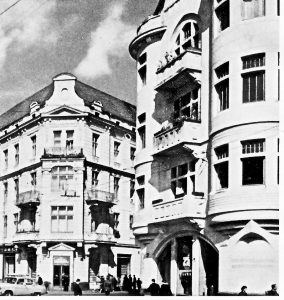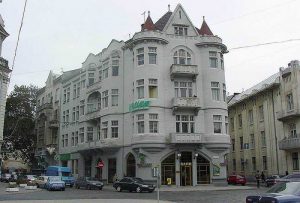In the next episode of Fun & Games we return to the book One hundred problems in elementary Mathematics, by the Polish mathematician Hugo Steinhaus (1887-1972). So today we will dedicate this entry to continue with the stories of the Scottish Café (the first story was published in the entry Steinhaus and Banach).

Mathematics requires for its blossoming an appropriate atmosphere that stimulates close contact between collaborators. Steinhaus, Banach and their people found this “appropriate atmosphere” in the noisy, warm and aromatic atmosphere of Lwów’s cafés, especially in the so-called Scottish Café. By 1930, Lwów must have had about 200,000 residents and, according to some local chroniclers, it was a beautiful city rather like Prague. The Scottish Café was decorated in the Viennese style, with small white marble tables, an excellent material that our mathematicians could not resist decorating every evening with a good dose of formulae and equations, written in pencil, of course.
The mathematical gatherings took place throughout the 1930s and until the Nazi occupation of the city in mid-1941. Stanislaw Ulam, one of the mathematicians who took part in them, tells us what happened at these gatherings. Ulam was Jewish and emigrated to the USA in 1936, as he did not see much of a future in Poland for a Jewish mathematician. When World War II broke out, he participated at Los Alamos in the manufacture of the first atomic bombs, and later, and in a prominent way, in the production of hydrogen bombs.
The ambience of the Cafés was not exactly relaxed discussions, rather they tended to be long, hard and lively: “I remember a session with Mazur and Banach in the Scottish Café,” wrote Ulam, “which lasted seventeen hours without interruption, except for meals”. The mathematical discussions did not go unnoticed by the other customers: “It was not uncommon that after a period of meditation several attempts at conversation would break out at once,” Ulam recounted in his memoirs; “someone would then scribble a few notes on the marble of the table while another would laugh hilariously. Then would follow another long period of silence in which we drank coffee and watched each other indolently. Our strange behaviour kept the customers at nearby tables in a permanent state of bewilderment”.
Generally, there was quite a lot of expense: lots of coffee, large doses of brandy, huge quantities of cigarettes, and –although the Scottish Café was not exactly a delicacy– some food.

Mathematical geniuses from other parts of the world also took part in the gatherings: John Von Neumann, to mention just one example. Von Neumann visited Lwów on several occasions and naturally took part in the discussions at the Café. According to Ulam, on one such occasion: “Banach and other mathematicians got von Neumann so drunk on vodka that he had to leave the table to visit the toilets; but he came back and continued the mathematical discussion without having lost the ability to reason”. As can be seen, it sometimes happens that one has to do mathematics while drunk, although it is not the most convenient or fruitful thing to do. Banach, like von Neumann, had a reputation as a good drinker; his stepsister wrote: “My brother drank enormous quantities of coffee and alcohol, although he had an incredible capacity for endurance. He once attended a conference in Georgia. The tradition there is to drink a toast during the celebratory meal to the health of the participants: the rule is one toast per participant, and the corresponding glass of strong Georgian vodka has to be drained in one gulp. Banach outlived all the local participants of the meeting, and stood on his feet while the other mathematicians disappeared one by one under the table”. I was not, of course, at that meal, but I have been to a similar meal in Moscow, and I can vouch for the fact that things end up happening just as Banach’s stepsister tells them in her story.
The mathematical meetings at the Scottish Café ended up transcending the local sphere to fertilise a fairly significant part of the mathematics produced in the last quarter of the twentieth century. And they did so by means of a notebook in which the participants wrote down the problems they discussed: the Scottish Notebook. But I will discuss this in the next article.
References
A.J. Durán, Pasiones, piojos, dioses… y matemáticas, Destino, Barcelona, 2009.
S. Ulam, Adventures of a mathematician, University of California Press, Berkeley, 1991.

Leave a Reply